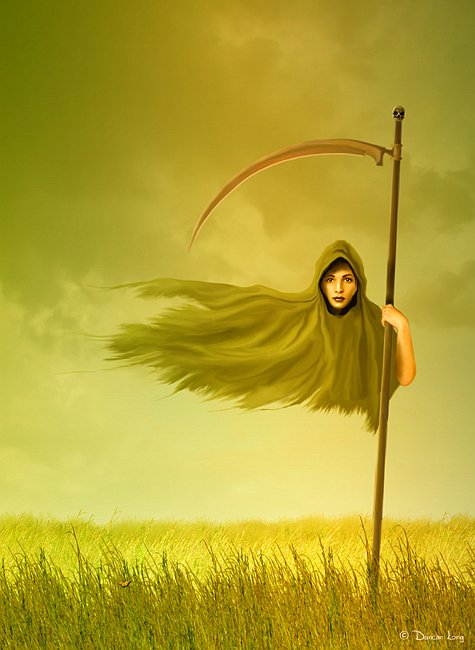3 Questions and More Answers Than You’ll Want to Read
filed in Book Cover Illustrations and Artwork on May.27, 2011

Book cover illustration: Death Wore a Mini-Shroud by Duncan Long
Questions: How on earth do you get the intricacy of detail in your artwork? I understand how you could manage it with a fine brush or in pen-and-ink but how do you manipulate lines and curves? How do you get the gradations of color? I’m astonished, impressed, and intrigued simultaneously.
Answers: All my illustrations are done on a computer workstation (current an HP), inputting my “painting” by working with a Wacom digital tablet. My software is mostly Corel Photo Paint, using the oil and watercolor modes. I’ve found I can work much, much faster by cutting out the actual physical drawing or painting and going directly to pushing pixels on my PC. This also makes sending sketches as well as the final book cover illustrations to clients much easier (generally as email attachments).
Some of the gradations of color in my artwork are simple gradients where the computer does most of the work after I’ve chosen the color extremes for it to work from (I often to into the picture afterward and add some fog-like swirls to keep things interesting). But most of my color blending is done by hand, painting with virtual brushes that add just a little color with each stroke. I then use a blending “brush” to average out, shade, and adjust elements in the painting.
(I should note that these are virtual brushes within Photo-Paint; the digital tablet stylus is basically like an ink pen; the software transfers the actions to something similar to a spray can or paint brush depending on what I select. I use an old version of the Photo-Paint (version 8 — current version is 15); it doesn’t have a lot of brushes, but it has a handful that work well and those serve all my needs for the most part as I create my book illustrations.
The computer can create very straight lines — but generally I avoid those for more natural-looking hand drawn lines. Often I have to go in and roughen lines to keep them looking like a part of a painting.
Some of the detail in my illustrations (in grass, trees, stars, or other repeated patterns needing a more or less random effect) is achieved by creating the basic picture of blades of grass or trees and then converting them into a series of “spray” images that can be randomized to make for a more natural appearance as they are laid down over the painting.
With hair, I often employ a wide-bristle “brush” as well as a wide bristle blend “brush.” These take a lot of adjusting to get right, and I have come to think the ideal portrait would be of a bald subject.
Finally there is a whole lot of grunt work in painting my artwork (ha). But the computer makes all of it a lot faster and more precise than would be the case with actual paints.
Oh… Almost forgot. My most important tool. It often proves to be the undo key (control-z).
====================
Duncan Long creates book cover illustrations from electrons — though many people mistake them for oil paintings or the like. You can view more of his artwork at Duncan Long’s Illustration Portfolio
=====================
May 27th, 2011 on 5:26 pm
Your artwork is so good. Such talent. Excellent in both your realistic renderings as well as the more surreal. Some remind me a little of Norman Rockwell and Andrew Wyeth at their best, yet you have a style all your own.
May 28th, 2011 on 10:28 pm
Bobette B drew attention to your work on Facebook. I am a writer of numerous articles and currently at work on a memoir and novel.
Your work is superb! I’ll be back after I finish polishing my Hummer.
David AKA Bruce
May 31st, 2011 on 9:53 am
The butterfly in this one is inspired. And the flowing mantle directs the eye as if there is a finger pointing West. Terrific.